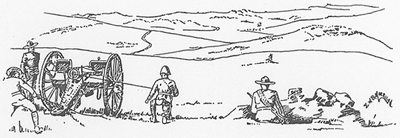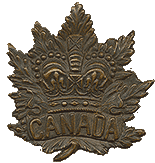Battles
Leliefontein
7 November 1900
 “Boers on the sky line”. A scene that
would have confronted the gunners of “D” Battery and the Royal
Canadian Dragoons at Leliefontein. A Dragoon with bandolier stands guard
to the right.
“Boers on the sky line”. A scene that
would have confronted the gunners of “D” Battery and the Royal
Canadian Dragoons at Leliefontein. A Dragoon with bandolier stands guard
to the right.In the early morning of 6 November, a strong British column left the eastern Transvaal town of Belfast and rode south to disperse a large Boer commando reported to be camped about thirty kilometres to the south near the Komati River. The force included the Canadian Mounted Rifles, the Royal Canadian Dragoons, and one section of "D" Battery, Royal Canadian Field Artillery, with two 12-pounder guns. After forcing the commando back across the river, the column camped for the night near a farm named Leliefontein. Boer resistance had been stronger than expected, however, and the British commander expected them to be reinforced during the night. He therefore issued orders for a return to Belfast in the morning. The Boer commander, who had brought up reinforcements, believed that the British would continue their advance, and prepared to meet them on the road heading south in the morning.
To cover his withdrawal, the British commander detailed the Royal Canadian Dragoons and the two 12-pounder field guns of "D" Battery as his rearguard, all under the command of Lieutenant-Colonel François-Louis Lessard of the Dragoons. The Dragoons were seriously under strength, mustering no more than one hundred men and a horse-drawn Colt machine gun. However, the Canadian horsemen and artillerymen were experienced, and had worked together long enough to operate as a team. The Dragoons deployed in a line four or five kilometres across covering the rear of the departing British column with the guns and the machine gun in the centre.
As soon as the Boers realized that the British were retiring, large parties began to press the Canadian rearguard. (See maps) During the morning the Boers mounted a series of strong attacks at various points along the Canadian line. These attacks culminated in a charge by two hundred mounted Boers firing from the saddle that threatened to break the Canadian line and capture the two field guns. The charge was only beaten off by the gallantry of a small party of Dragoons and the fire of the machine gun, which killed the two Boer commanders. The Boers continued to attack, but the loss of their leaders had disoriented them, and as the Canadians neared the rear of the retreating British column, the Boers lost momentum.
Leliefontein was the most desperate situation faced by Canadians during the war. The number of decorations, including Victoria Crosses to Lieutenants H.Z. C. Cockburn, R.E.W. Turner and Sergeant E.J. Holland, all of the Royal Canadian Dragoons, attests to the intensity of the fighting.
